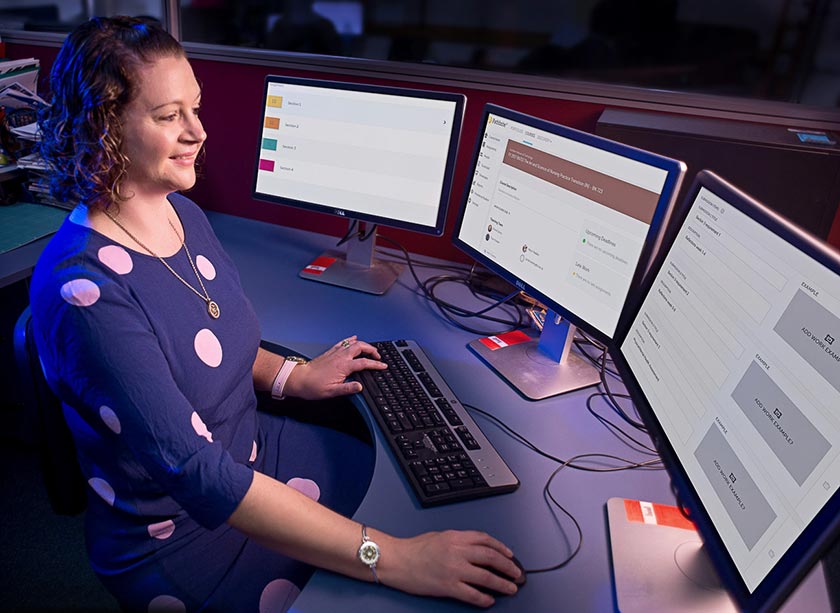ePortfolios – do undergraduate nurses find them useful or not? That is the question.
What is an ePortfolio?
An ePortfolio is an electronic platform for students to record their work, goals and achievements, to reflect on their learning and receive feedback, all kept in one convenient place.
The Southern Institute of Technology (SIT) introduced ePortfolios in 2019 for both second- and third-year bachelor of nursing students. Gone are the days of collating multiple pieces of paper into a three-ring binder, agonising on the order of documents and physically delivering the portfolio when it is time for it to be handed in.
It has been well established through international literature1, 2, 3, 4, 5 that ePortfolios can provide students with a means of learning, collaborating and presenting their academic requirements in an interactive, visual and flexible manner. Research1, 2, 3, 4 recognises the critical part ePortfolios can play in a student’s learning experience.
There is limited research on student perceptions of ePortfolio platforms3, 6 which looks specifically at whether students find value in using them and, more importantly, whether using them enhances their reflective practice.
Paper vs ePortfolio
The Ministry of Education describes an ePortfolio as an electronic platform for students to record their work, goals and achievements, to reflect on their personal learning and receive feedback, all kept in one convenient place.7 The merits of paper-based portfolios vs ePortfolios have been a point of discussion. As the move to an electronic world continues to evolve, which platform do students find supports their learning the most?
In the nursing profession, portfolios are commonly used to collect evidence of ongoing competence and capability. They can be defined as a collection of professional work that follows the trajectory of a nurse’s career, and that should illustrate the individual nurse’s background, skills and expertise.7 In both the profession and in undergraduate education, this method of obtaining evidence of knowledge and skill has been regarded as effective and sound. Traditionally, nurses have assembled evidence of their clinical competencies in a paper-based portfolio. Development of the ePortfolio format in education provides an alternative.
Three-year study
Do undergraduate student nurses find ePortfolios beneficial over the duration of their course? There is little literature exploring ePortfolios from students’ perspectives and within the field of nursing, hence the need for exploration of this topic. Last year, 2020, was the final year of a three-year mixed methodology longitudinal study at the Southern Institute of Technology (SIT), which explored this question.
International research shows use of ePortfolios leads to higher retention and success rates for students.8 However, there is a dearth of information about student perspectives.
In 2017, SIT nurse educator Karyn Madden started a nine-week study to explore student perspectives on ePortfolios. Ten final-year nursing students were enlisted to the study, which concluded that students preferred ePortfolios over paper-based equivalents.
Once students understood how and where to upload documents, they found the process straightforward and efficient.
The need for more comprehensive research was highlighted, which led to the development of a longitudinal study to determine if students still found ePortfolios beneficial over their three years of study.
This research followed a cohort of undergraduate bachelor of nursing students who were invited to complete an online questionnaire, with data being collected and analysed yearly. The first two years of data have been analysed. This article presents the second year of data and compares it to the initial data from the first year. Both quantitative and qualitative data was gathered.
Data from the second year revealed three interlinked themes – technology, feedback and reflective practice. Positive themes that emerged were that the portfolio was accessible at any time and place, provided that internet was available; also all the portfolio material was in one place, which allowed easy access and meant material could not be misplaced.
Once students understood how and where to upload documents, they found the process straightforward and efficient. Time was saved by not having to collate or handwrite documents. Trees were saved as the portfolio did not need to be printed.
Timeliness of feedback from nurse educators was identified as another important element, as it helped students improve the quality of their work and progress their portfolio, and aided reflective practice. Students were able to reflect both on areas where they could improve and where they had excelled. Through reflective practice, students were able to link classroom theory with clinical practice.
A few students did not feel the use of an ePortfolio enhanced their reflective practice, as they were required to complete the work anyway and the act of uploading had no drastic impact. The challenges identified by students in the use of ePortfolios concerned technology, personal preference and timing of feedback.
Positive view
Overall, the use of ePortfolios and their value for students in an undergraduate nursing degree has been viewed positively. Findings from this research support the claim that the integration of ePortfolios into the educational routine is effective and the relationship between technology and academic elements can be positive. In a world that is moving towards increased use of technology, the inclusion of effective systems utilising technology has the potential to create positive outcomes.
The final data, from the third year of the study, 2020, has been collected and is being collated and analysed. It will be presented during 2021.
Lead researcher Karyn Madden, RN, MN, DipAdultEd, PhD candidate, and researchers Katrina Bowes, RN, PGCert HSci-MSME, CertAdultEd, Michelle Miller, RN, BHSciNurs PGDipHSci, and Stacey Porter, RN, PGDipHSci, CertPH, are nurse educators at the Southern Institute of Technology, Invercargill.
References
- Andrews, T., & Cole, C. (2015). Two steps forward, one step back: The intricacies of engaging with eportfolios in nursing education. Nurse Education Today, 35, 568-572. doi:10.1016/j.nedt.2014.12.011.
- Beckers, J., Dolmans, D., & Merrienboer, J. (2016). E-portfolios enhancing students’ self-directed learning: A systematic review of influencing factors. Australasian Journal of Educational Technology, 32(2). doi.org/10.14742/ajet.2528.
- Cordier, R., McAuliffe, T., Wilson, N., Totino, R., Dender, A., Smith, C., & Stephens, M. (2015). The appropriateness and feasibility of an online e-portfolio for assessment of undergraduate allied health students. Australian Occupational Therapy Journal, 63(3), 154-163. doi:10.1111/1440- 1630.12226.
- Dahlstrom, E., Walker, J. D., & Dziuban, C. (2013). ECAR Study of Undergraduate Students and Information Technology (PDF, 2.6 MB).
- Eynon, B., Gambino, L., & Torok, J. (2014). What difference can eportfolio make? A field report from the Connect to Learning project. International Journal of ePortfolio, 4(1), 95-114.
- Tosh, D., Light, T. P., Fleming, K., & Haywood, J. (2005). Engagement with electronic portfolios: Challenges from the student perspective. Canadian Journal of Learning and Technology, 31(3). https://doi.org/10.21432/T23W31.
- Green, J., Wyllie, A., & Jackson, D. (2013). Electronic portfolios in nursing education: A review of the literature. Nurse Education in Practice, 14(1), 4-8. doi:10.1016/j.nepr.2013.08.011.
- Madden, K., Collins, E., & Lander, P. (2019). Nursing students’ perspectives on ePortfolios: Themes and preferences compared with paper-based experiences. International Journal of ePortfolio, 9(2), 87-96.





